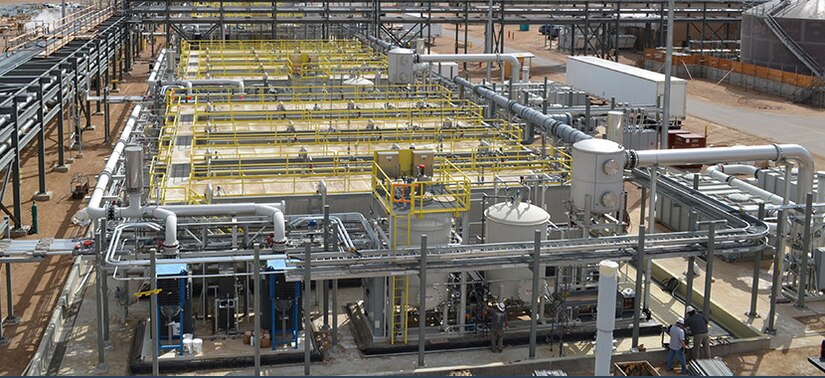This month, the Pueblo Chemical Agent-Destruction Pilot Plant team at the Army's Pueblo Chemical Depot in Colorado completed the destruction of nearly 300,000 155mm projectiles, which each contained 12 pounds of mustard agent, said Walton Levi, site project manager.
Chemical agent destruction operations in Colorado began in March 2015 and are scheduled to be completed by 2023, said Levi. More than 780,000 munitions were in the original chemical weapons stockpile in Pueblo.

Mustard agent is a blister-producing chemical weapon contained within three types of munitions stored at the Pueblo Chemical Depot, each named after the diameter of its shell: 155mm projectile, 105mm projectile and 4.2-inch mortar round, he said.
This marks the end of the 155mm projectile campaign at PCAPP and the safe elimination of approximately two-thirds of the original chemical agent stored at the depot, said Levi. ''We proudly completed this campaign ahead of schedule — and while implementing strict, new protocols to keep our workforce safe amid the coronavirus pandemic,'' he said.
Since the late 1960s, the U.S. government has been taking steps to reduce and eliminate the U.S stockpile of chemical weapons. This was reinforced by a presidential directive and the U.S. ratification in 1997 of the Chemical Weapons Convention, an international treaty that calls on all member nations to destroy their chemical weapons and production facilities.

To comply with the treaty, the U.S. is destroying its last remaining chemical weapons stockpile, said Levi.
''Our ultimate goal is keeping the workforce and community safe from these World War II-era weapons,'' said Army Col. Michael Cobb, commander of the depot. ''We use the utmost care and follow strict safety procedures when delivering the munitions from their storage igloos to PCAPP.''
''Destruction of 155mm projectiles is a great accomplishment for the PCAPP team,'' said Ken Harrawood, project manager of the Bechtel Pueblo Team. ''Innovative solutions are key to solving issues that arise with a complex and one-of-a-kind operating facility like PCAPP. This would not have been possible without the dedication and professionalism of our amazing workforce.''
''I give credit to our team of employees dedicated to the munitions destruction effort, as many have spent their entire careers ridding the world of these weapons,'' said Kim Jackson, plant manager. ''We reached this milestone because of the amazing workforce and their diligence, hard work and support to the PCAPP mission.''
''The United States is fully committed to destroying 100% of its remaining chemical weapons stockpile by Dec. 31, 2023,'' said Mike Abaie, program executive officer of Assembled Chemical Weapons Alternatives.

As of Aug. 14, the destruction of 1,673.5 tons of mustard agent in the U.S. has been reported to the Organization for the Prohibition of Chemical Weapons, an intergovernmental organization whose goal is to eradicate chemical weapons worldwide, said Abaie.
How the Process Works
Under the close supervision of trained operators, the pilot plant uses dozens of automated systems to disassemble and drain the munitions and thermally heat the drained munition bodies, said Levi.
The liquid agent is neutralized, and the product, hydrolysate, is then fed to living microorganisms in a process known as biotreatment, Levi explained. Water is recycled at the pilot plant and the remaining salt is shipped off-site to a permitted treatment, storage and disposal facility. The plant is equipped with a robust pollution abatement system made up of 12 carbon filter banks that filter out particles before air from inside the plant is released back into the atmosphere.
During the next several months at PCAPP, technicians will retrofit the plant’s robots and systems to begin processing the next munitions campaign, which are the 105mm projectiles, said Levi.
In July, workers finished assembling three static detonation chambers to augment PCAPP by destroying problematic munitions, which are unsuitable for processing using the main plant’s automated equipment, said Levi. The SDC units will destroy the 4.2-inch mortar rounds, which is the third and final destruction campaign.

Other Chemical Weapons Site
The other remaining chemical weapons facility in the U.S. is PCAPP's sister site, the Blue Grass Chemical Agent-Destruction Pilot Plant near Richmond, Kentucky. BGCAPP is safely destroying 523 U.S. tons of the nerve agents VX and GB (sarin) and mustard agent stored in rockets and projectiles at the site, Levi said.
BGCAPP is using neutralization or an explosive destruction technology to safely destroy the munitions, he continued. BGCAPP began agent destruction operations with explosive destruction technology on June 7, 2019, and its main plant began operations on Jan. 17, 2020. Operations will be completed by Dec. 31, 2023.
An important element in the process of safely destroying chemical weapons is the coordination and collaboration with the local communities. The Chemical Stockpile Emergency Preparedness Program works closely and supports state and local governments and the Federal Emergency Management Agency to educate, prepare and protect communities surrounding the stockpile sites, Levi said.






No comments:
Post a Comment